Every week, I get emails from people that are based in countries with worse economies than where I’m based.
Usually, they explain that they would love my online course, but that the enrolment fee is equal to multiple monthly salaries in their country 🤯
I never knew what kind of discount to give, and it if it was fair to other people at all.
That was until I stumbled across Purchasing Power Parity which promises to increase your revenue ánd make your courses more accessible to all.
In this article, I’ll share what it is, how you can implement it & my results with it.
Let’s dive in! 🚀
Part 1
About Parity Pricing
What is it?
How do you calculate it?
Why bother?
What is Purchasing Power Parity?
Purchasing power parity (PPP) is a way to compare how much stuff we can buy in different countries, based on exchange rate & purchasing power.
For example, let’s say milk costs $5 in the United States and $4 in India 🐮🥛
You might then think that milk is cheaper in India because $4 is obviously less than $5.
But if the average income in India is much lower than the average income in the United States, then people in India might not be able to afford the milk even though it might seem cheaper.
What is Parity Pricing?
So with Parity Pricing, we want to try to level out the pricing by providing a discount or changing the price so that people from different countries should be able to buy the same amount of stuff, even if their purchasing power is much lower.
How do you calculate the discount?
You don’t have to put a wet finger in the air to guess what kind of discount would be fair for different countries.
There are lists with data, and PPP calculators that you can use to calculate how much discount someone should get.
Here’s a short list of examples for 2022 based on if the business were based in the United States 🇺🇸
(the discount should be different if you’re from a different country because the difference in purchasing power might be less or more)
| Country | Discount |
| 🇺🇸 United States ← origin country | – |
| 🇮🇳 India | 69% |
| 🇨🇿 Czechia | 40% |
| 🇧🇷 Brazil | 53% |
| 🇵🇭 Philippines | 61% |
So if milk costs $5 in the United States, it should cost $1,55 in India based on the purchasing power there.
And $3 in Czechia, or $2,35 in Brazil.
(off course all in local currencies, not US dollar)
Methods of doing parity pricing
There are two methods of doing parity pricing.
Method #1: discount coupon
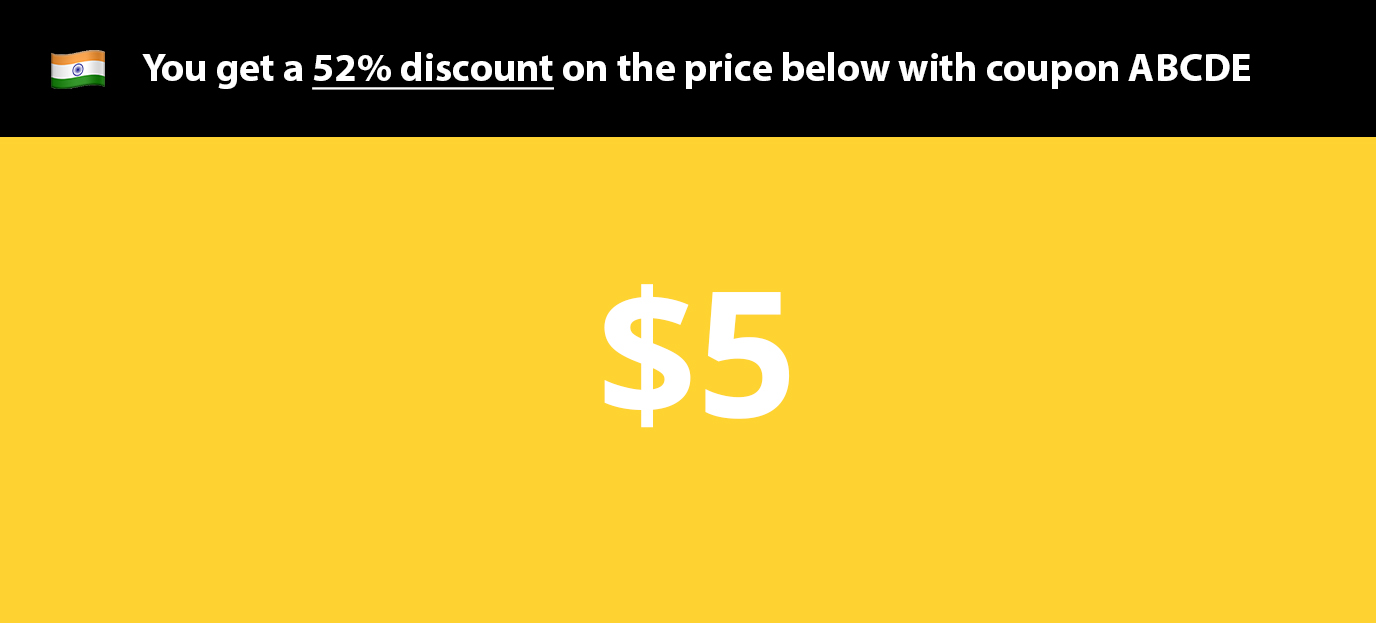
Visitors see a banner at the top of the page if they are from specific countries that are eligible for a discount. People who don’t get a discount, don’t see the banner.
Super simple to implement, as you only have to generate a couple of coupons & show them to visitors inside a banner based on where they are from.
Will talk about the free tool you can use to display that banner in a bit.
Method #2: dynamic pricing
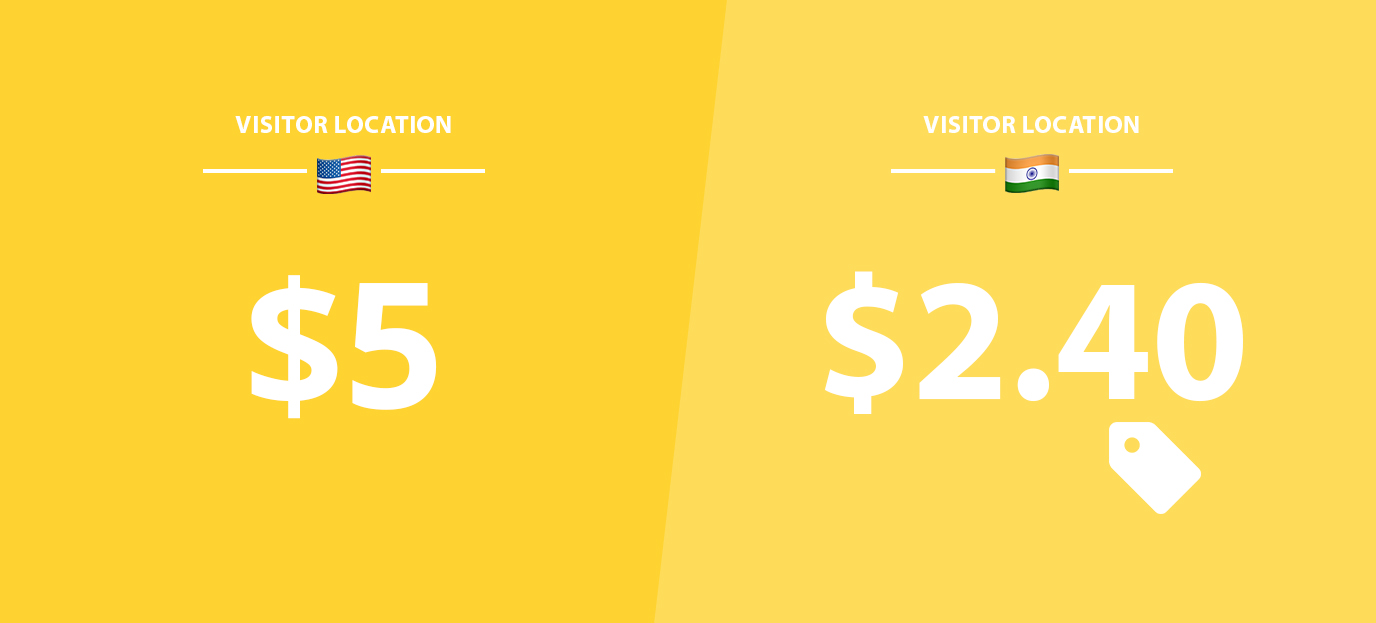
The price changes dynamically on the sales page & checkout page based on where visitors are from, they don’t even know they’re getting a lower price compared to people in some other countries.
Way harder to implement, since you need to be able to dynamically change all the prices on your website, plus the amount in the actual checkout.
Examples of businesses doing parity pricing
Netflix
Many subscription based companies have some kind of parity pricing, including Netflix.
🇺🇸 $9,99
🇩🇪 €12,99 ($13,80)
🇮🇳 ₹499 ($6,02)
As you can see, a monthly standard-subscription costs $6.02 in India, while I’m paying $13.80 in Germany
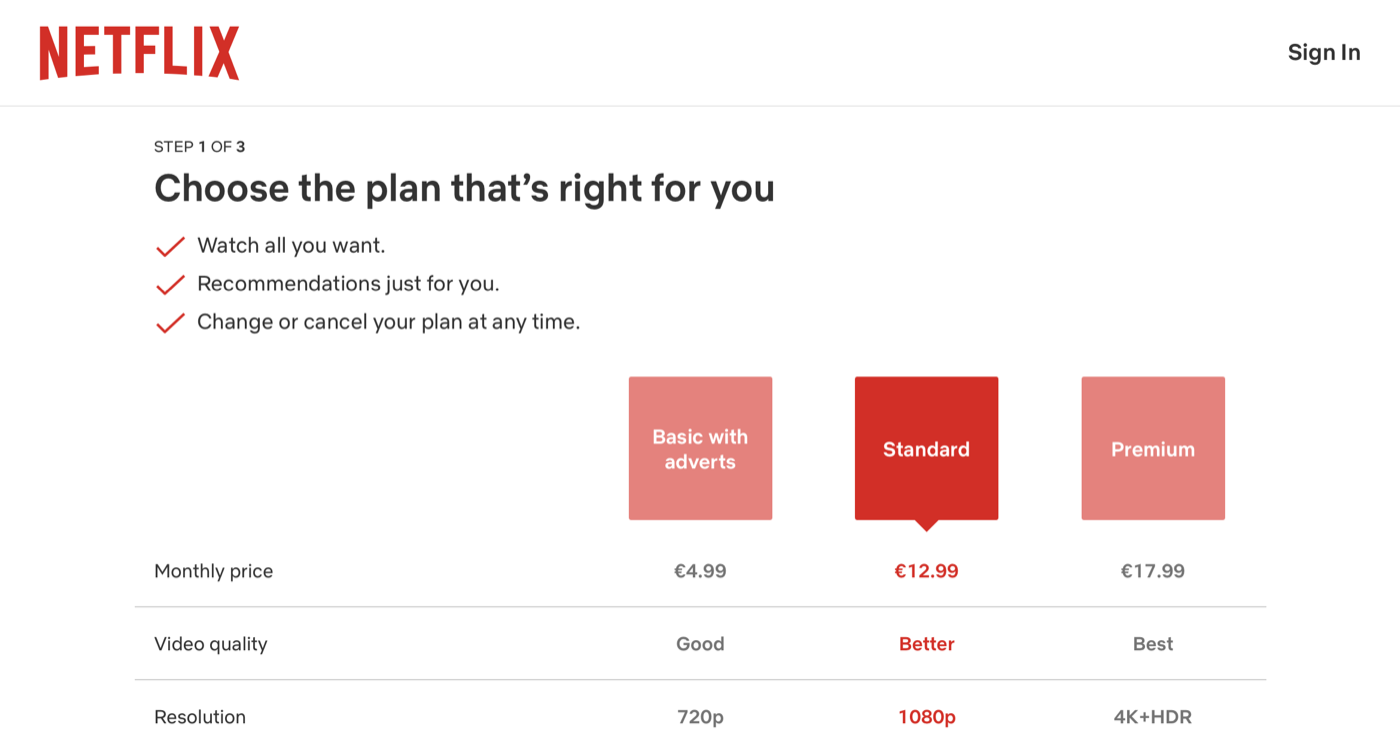
Maybe there’s more to the prices than just Parity Pricing Power. Maybe people in Germany are just willing to pay more than people in the US. Who knows?
Nevertheless, I think it’s a good example of dynamic pricing.
McDonalds
This is what a Big Mac costs around the world:
🇺🇸 $5,15
🇩🇪 $4,77
🇮🇳 $2,39
Maybe not a internet business, but I thought it’s good example to include anyway.

(sorry if this makes you hungry, hehe)
The Big Mac is such a good ‘offline’ example because they’re all mostly made of the same ingredients, which is why there’s even such a thing as the Big Mac Index.
Slow Growth
I love Matt D’Avella his content, and the work he’s doing with Slow Growth Academy.
Seeing that he started with parity pricing started my exploration of the idea.
(I had never even heard of the term ‘parity pricing’ before)
Below you’ll see an example of how he does parity pricing.
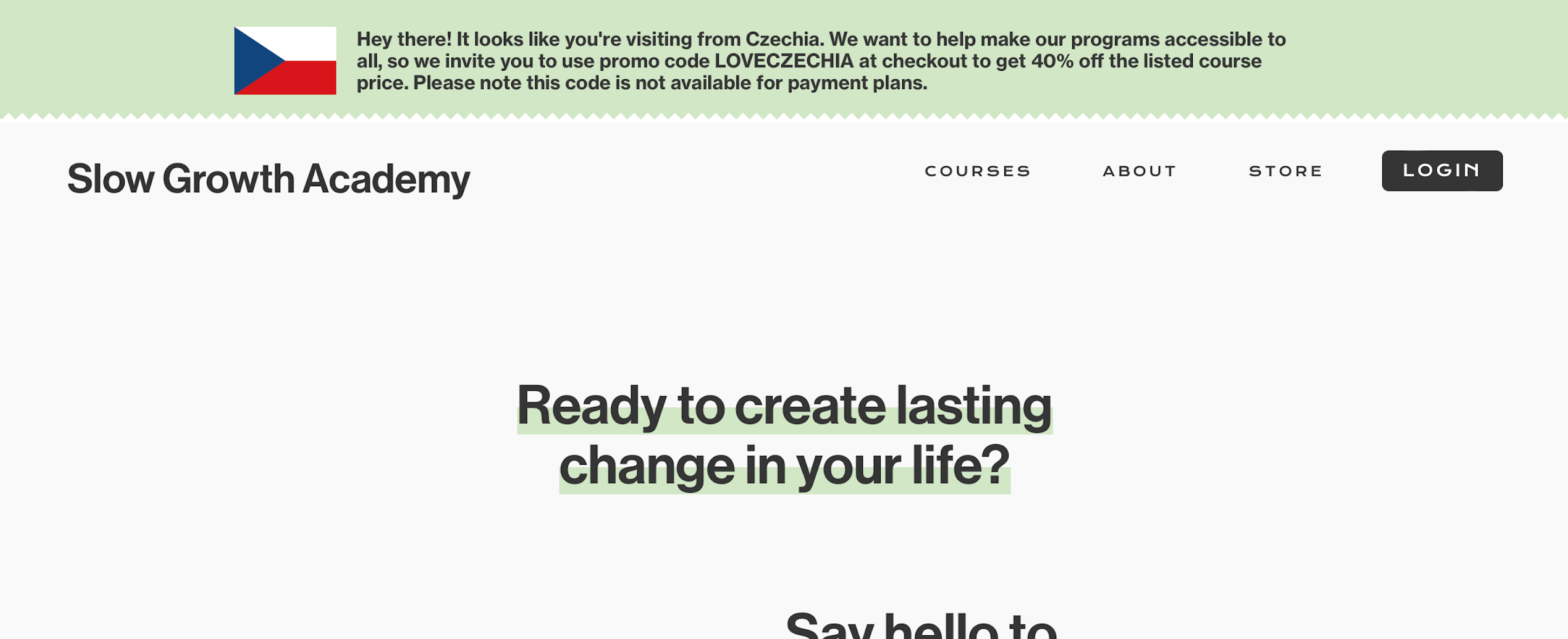
The discount depends on where you are from.
🇺🇸 full price
🇩🇪 full price
🇮🇳 50% discount
🇨🇿 40% discount
Part 2
How to set up Parity Pricing
It’s pretty easy.
And you can do it with a simple free tool.
In an ideal world, I think it’s probably best if the price would dynamically change based on the country someone is in.
But that’s rather complex to set up because you would have to dynamically update the price on all your sales page & checkout pages.
I’m quite techy, but I would have no clue where to get started with that 🤷♂️
Luckily, there’s a cool solution that takes only 10 minutes to setup without any coding.
Parity Deals
Sachin Neravath made a tool called Parity Deals, which allows you to display a banner at the top of your sales pages like this:
🇮🇳 Hey there! It looks like you are from India. We support Parity Purchasing Power, so if you need it, use code “ABCDE50” to get 50% off your purchase at checkout.
The country, percentage & discount code will be automatically swapped out depending on where someone is visiting from.
Customizing the bar is easy:
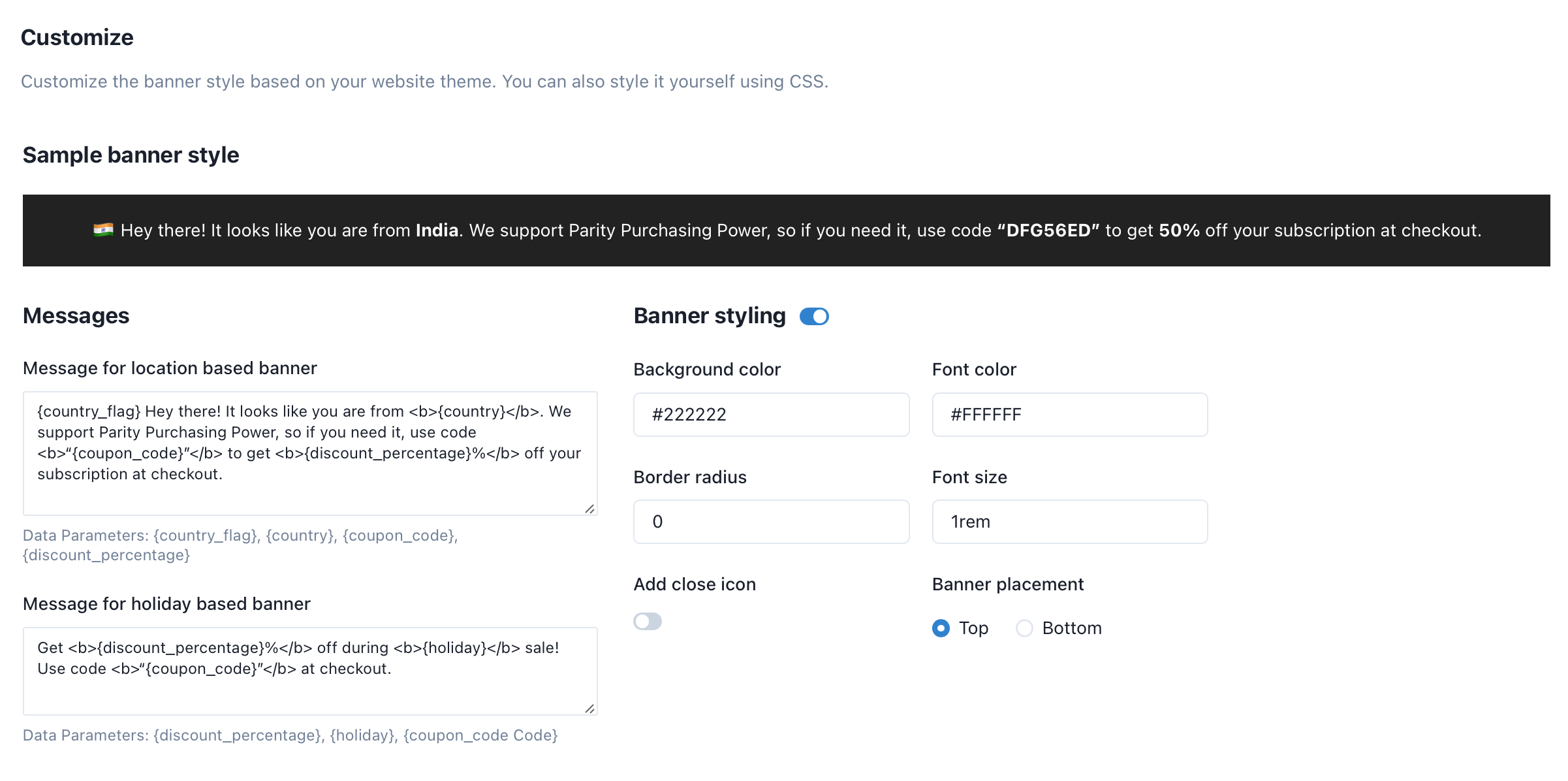
And setting a discount percentage & coupon for each group of countries is also a piece of cake:
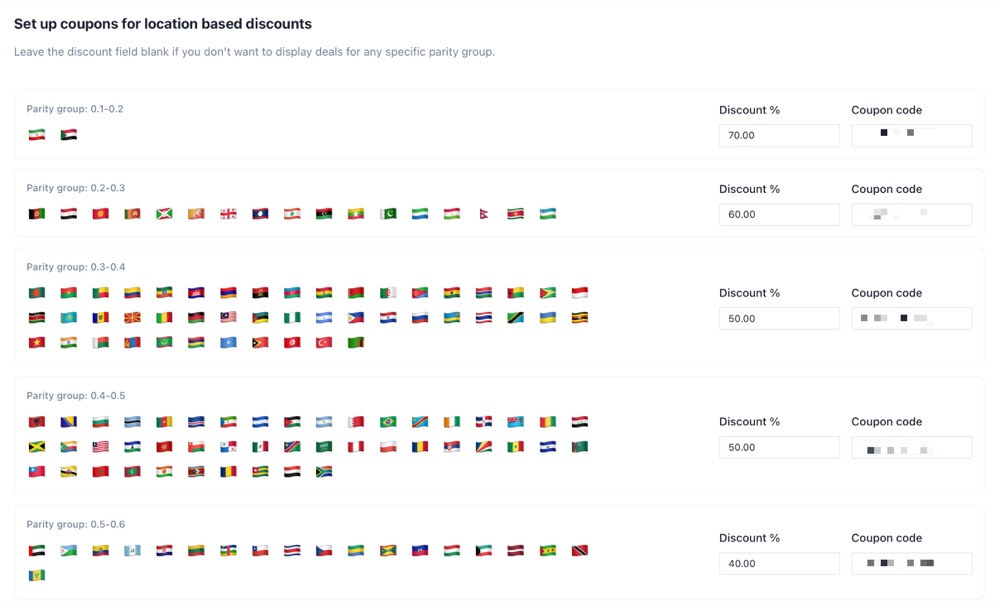
You will then get a script, which you have to add to the pages where you want to display the banner.
Part 3
My 31-day experiment
My doubts before going into this?
Where does my traffic come from?
What results did I got?
I figured there’s no way to tell if parity pricing would work for my online course business besides testing it.
Below I’ll share my thoughts before & after the experiment.
Doubts before the experiment
I honestly had some doubts about doing this.
Doubt #1: abuse
While I’m not super worried about it, people could definitely abuse this parity pricing model because it’s based on someone’s IP-address alone.
So if they would use a VPN, or ask a friend in such a country, they could potentially use a coupon code that they are actually not allowed to use.
But it’s rather easy for me to check invoice details, and to see where someone is actually watching the course from.
Not sure what I’ll do then, but I’ll definitely be pissed if someone from Switzerland is using a coupon that’s meant for someone in a low-income country.
Doubt #2: is it insulting?
During my research, I came across an article from Prerna Malik about how automated parity pricing is misguided.
In the article, she explains that her business partner and herself felt insulted because course creators assumed they couldn’t afford the $197 or $997 course fee – just because they are from India..
I find this really difficult.
Off course I don’t want to insult anyone by assuming they’re poor because they are from a country where income and/or purchasing power is lower on average.
I understand really well that there’s people with very high incomes, very low incomes, and everything in between in a country.
Right now I’m leaning towards; I probably help more people than that I insult because it’s based on the purchasing power parities of that country, and I hope that everyone sees my intentions are good.
But in the future it would maybe be better to dynamically adjust the price instead of showing a banner, so that people don’t even realise they’re getting a discount because they are from a lower-income country.
Netflix is already doing this: in India a monthly subscription costs $2.44, while I’m paying $13.50 in Germany.
Doubt #3: is it fair?
Sure, giving someone a discount if they’re from a low-income country sounds pretty fair to me.
But what about people with very low-incomes in high-income countries? There’s definitely people like that too, and it would love to give choose people a chance as well.
The problem is that I don’t see a way to automate that besides offering zero-interest payment plans 🤷♂️
And I’ve had a bad experience offering those; I was pretty busy managing failed payments, and I don’t want people to buy something they can’t afford.
Where my traffic & customers comes from
When I look at the last 90 days, this is the top 10 of where visitors are from:
| Visitors (top 10) | |
|---|---|
| 🇺🇸 United States | 19.49% |
| 🇩🇪 Germany ← I’m based here | 11.45% |
| 🇬🇧 United Kingdom | 5.72% |
| 🇵🇭 Philippines | 4.97% |
| 🇳🇱 Netherlands | 4.00% |
| 🇧🇷 Brazil | 3,99% |
| 🇮🇳 India | 3,92% |
| 🇦🇺 Australia | 3,61% |
| 🇨🇦 Canada | 3,45% |
| 🇫🇷 France | 2,17% |
While the majority comes from countries with strong purchasing power, it’s definitely not all of them.
And this only accounts of 61,78% of the visitors.
The other 38,22% is divided over the rest of the world, including many many lower-income countries.
So it probably doesn’t surprise you that most of my sales happen in high-income countries:
| Customers (top 5) | |
|---|---|
| 🇺🇸 United States | 44,81% |
| 🇩🇪 Germany ← I’m based here | 6,64% |
| 🇬🇧 United Kingdom | 4,98% |
| 🇳🇱 Netherlands | 4,56% |
| 🇦🇺 Australia | 3,73% |
It does sometimes happen that someone from, for example, the Philippines or India purchases one of my courses.
But that’s such a low percentage.
And that makes me a bit sad because I create content in English, which is not my native language, so I can help more people around the world.
What I hope to learn from this experiment
I’ve a few questions I hope to get answers to:
- Will more people from low-income countries to purchase my course?
- Will I generate more revenue because more people are able to get my courses?
- Will I get any negative feedback from this?
- Will parity pricing be abused?
I’ll report later on each of the above questions.
Start of the experiment
On the 28th of November, I’ve created an account with Parity Deals, created some coupons in ThriveCart, and have set up a discount banner in 10 minutes.
I’m very curious how this will go!
Results of the experiment
It’s now the 3rd of January as I’m writing this, a bit more than a month into the experimentation.
To make things easy, I just took the complete 31 days of December 🗓
Visitors
A total of 288 people visited a sales page for one of my online courses.
Most of them came from the United Sates, Germany, Brazil, and India.
Here is a screenshot of the Parity Deals dashboard with an overview of where people came from:

This data isn’t so super exciting.
But what I do find interesting, is the visitors based on their PPP value:

As you can see, most of my sales page visitors have a PPP of 0.9-1.0.
Not surprising since most of them came from the United States & Germany.
But there’s also plenty of people with a PPP of 0.3-0.6.
Sales
December is usually a bit of a slow month because of the holidays. People spend less time working & want to spend their money elsewhere.
A total of 22 people bought 24 courses, generating $8542,81 in revenue in total.
2 people from Brazil bought 3 courses with a 50% parity pricing coupon, which generated $648,50 in revenue.
Overal thoughts
In my 31-day experiment, 2 extra people bought my course, generating 7.60% extra revenue.
When reviewing the results, I realise that the amount of time for this experiment is too short, and that december wasn’t maybe a good month to experiment this with as my sales are usually a bit lower this month.
My website isn’t getting hundreds of thousands of visitors, and I’ll extend this experiment with another two months to get more definitive results.
Part 4
Conclusion
Will I keep doing parity pricing?
Do I recommend it to others?
I think Parity Pricing is interesting if you have a global audience.
And while I’m not done with my experiment yet, so far I see it pretty much as a win-win situation.
You get to increase your revenue as an online course creator, and make your courses more accessible in the process 🤗
And while I think automated parity pricing might not be the ultimate solution for equality, I think this is as best as it gets.
Ultimately I think it would be best to change the price dynamically so that people don’t even realise they’re being treated any differently.
But I think that the implementation of that is pretty difficult while showing a banner with a tool like Parity Deals with a coupon code is super easy.